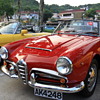Posted 11 years ago
 bluemax1914
bluemax1914
(71 items)
This unusual Reservist’s flask belonged to Gefreiter (Private 1st class) Urmetzer, a Hussar who was a member of the 5th Squadron of the 7th (1st Rhenish) Hussars, “King William I” from 1909-1912. This cavalry regiment was raised in March of 1815, and was a part of the 16th Division, attached to the VIII Army Corps, incorporated into the 4th Army just prior to and during WWI. The unit was garrisoned in Bonn, a city on the banks of the Rhine River in the State of North Rhine-Westphalia. Founded in the first century BC as a Roman settlement, Bonn is one of Germany's oldest cities.
Hussars were light cavalry used for reconnaissance and to probe enemy lines, and on the eve of World War I, in addition to Germany, there were still hussar regiments in the British and Canadian Armies—(Winston Churchill served in the 4th Queen’s Own Hussars in the late 19th Century) as well as the French, Spanish, Russian, Dutch, Danish, Swedish, Romanian and Austro-Hungarian armies. Hussars were notable for their colorful and elaborate parade uniforms.
As the war wore on, cavalry units became dismounted infantry, some evolving into armored units still designated as “Hussars” in WWII.
The obverse of this porcelain flask depicts two hand-painted mounted Hussars vaulting a fence or obstacle as they ride forward into the fray. On the reverse, again rendered by hand, three Hussars walk arm-in-arm through Bonn as they make their way home. The viewer can determine that they have served out their time (3 years for mounted units) in the Reserve because their epaulettes are rolled on their shoulders as per tradition. The flask is capped by a spread-winged Imperial eagle, perched on a flagpole that displays the national flag in red, white and black. This elaborate cap screws off to serve as a container for a shot of schnapps. The porcelain body and metal reinforcement on the flask are both in remarkable condition. A mystery is the color of the shoulder cord, which based on the military units to which this Reservist was attached, should be black and white (see the pennants on the lances). However, we have blue, gold and red, a phenomenon that I am unable to explain. There is little doubt that the cord is original to the flask. Perhaps a personal preference, the truth of it is lost to time. Mystery solved---the cord is colored to match the uniform: Ponceau red kolpak on the busby, yellow to match the braid, which decorates the Russian blue attila (tunic). My thanks to the Podiatric Surgeon who saw this piece at an auction somewhere in North Dakota, purchased it on my behalf and mailed it to Texas, where it now resides beside my Reservist’s stein collection. He saw my other similar flask on this venue, and though we had never met, contacted me and facilitated my acquisition of this fine flask.






















Great history & background. Thanks.
Regarding your Reservist's flask... I have one very similar, but am not a collector, per se, nor am I familiar with navigating this site. My flask belonged to my step-grandfather, Henry Brahmst. It depicts a single horse & rider on one side "Sieg oder Tod!" and the dates 1907-1910. The other side shows 5 small scenes surounding the numeral "5" (Reserve Unit?). A few differences from yours... Mine has 3 tassles, the cap is crowned by a "standing" horse & rider. The horse has to clear glass eyes, when held up to one's eye and a light source, would reveal a scene, with text, of a soldier bidding farewell to his mother at the doorstep. This image, unfortunately, has been lost during the many years I have had this piece. I would be happy to share/post photos but am unsure of how. I have never seen one until I saw your S&T post and thought you would enjoy seeing it, or providing me with information. Thanks for your interest.
cwnewbie,
Does the flask state what type of mounted unit in which Brahmst served (Kurassier, Dragoon, Hussar, Uhlan, etc.)? The glass eyes (stanhope) was a costly option that is rarely seen on flasks or steins, and very few have survived intact with the original image(s). Is it determinable in which what German state's cavalry he served? Each state retained it's own uniforms and identity, all subject to the will of the Kaiser. Most common are Prussian and Bavarian units, rarer are the smaller duchys (Oldenberg, Mecklenberg, Reuss to name a few). Units from Wurttemberg, Baden and Saxony are also fairly common. I would love to see a photo of both sides of the flask so that I may identify it for you. The process of uploading photos is not difficult, and in fact the site virtually walks you through the steps necessary. All you need to do is to photograph the piece, put the photos in a folder where you are able to find it, go the CW's site, and click on "post a new item". You will get an option to "upload photo", at which time you will direct the uploader to the folder in which your image is saved, click on it and it appears. You are allowed to upload four images. Then you add a description, select the categories where the article and photos will appear, and you are in business. I look forward to seeing your flask!